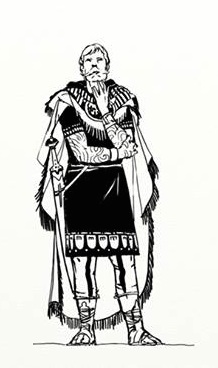These sketches by Jan Pospisil depict three nobles – the first from Esrolia, the second from Sartar, and the third from Tarsh.



This Esrolian noblewoman wears a close-fitting tube dress, sewn at the side, that is held up by two straps that attached behind the neck. The straps come together at the front and expose her breasts. The dress is made of fine linen or even silk and might be brightly dyed or nearly transparent. I imagine something like the Egyptian kalasiris:
- http://www.historiadeltraje.com.ar/images/Programa%20Hist%201/Kalasiris.jpghttp://www.fashion-era.com/images/100_bc_ALLancient_history/bwbare.jpghttp://www.womenintheancientworld.com/fashio2.gifhttp://di-ta.com/wp-content/uploads/2013/01/001.gifhttp://myrdinfashion.com/english/files/2012/02/egyiptomioltozet.jpg
(We’ve already hinted at this fashion with the picture of the Esrolian queen)
She wears a white feathered cape over her shoulders. She wears a large and ornate necklace of gold and gemstones, and bracelets of gold or precious stones. She also wears arm rings, showing her authority and status.She has large golden or copper earrings, possibly square shaped (showing her Earth connection). Her long hair is intricately braided and coiled upon her head in the Minoan or Mycenaean fashion (let’s avoid her looking too Egyptian). She wears kohl to rim her eyes, darken her eyebrows and eyelashes. She wears rouge on her lips. She is barefoot.
This Sartarite chieftain or petty king has adopted the Pelorian styles of his conquerers. He wears a long tunic that goes down to his knees over riding leggings. Over this he wears a long fringed cloak that goes down to near his ankles. Despite the “Pelorian style clothing”, he is still tattooed as a traditional Orlanthi with the runes of Air, Movement, and Mastery, as well as clan and tribal markings. Around his neck he wears a golden torc or pectoral that shows that he is a chief or king. These torcs are magical regalia and the symbol of his authority. He also wears an armband and bracelets. The noble has a beautifully decorate bronze sword – like a Mycenaean type B or C sword:
with a magical crystal on its pommel (the crystal is the blood of a god wounded in the Gods War). This sword is also part of his regalia of authority.
Fig. 3: Tarshite noble

This Tarshite nobleman from the capital city of Furthest is the height of Provincial aristocratic fashion. Although he still bears his clan initiation tattoos and markings of his tribal gods, he is also initiated into the Seven Mothers and bears both the Moon Rune and the rune of Yanafal Tarnils
His long beard is well-groomed, and has been curled with tongs to create hanging curls (http://wordinfo.info/words/images/beard-Grecian-curls.gif). He wears a long tunic that goes down to above his knees and leggings for riding. Over that he wears a long embroidered robe that goes down to his ankles, and has been split for riding. It is hemmed with fringe and decorated with patterns like:
- http://s704.photobucket.com/user/kenzo945/media/syrianarchers.jpg.html
- http://s342.photobucket.com/user/MBvonBlood/media/HittiteKing.jpg.html
He wears golden jewelry to display his status, including a golden neck ring (like http://images.ookaboo.com/photo/m/Torque_Susa_Louvre_Sb2760_m.jpg), golden bracelets, and arm-bands. He wears a decorated short sword (http://upload.wikimedia.org/wikipedia/commons/3/34/Bronssvärd_fr_Segerstad_sn%2C_Västergötland_%28Montelius_1877_s134_fig192%29.jpg).
It is likely belted over his shoulder.
